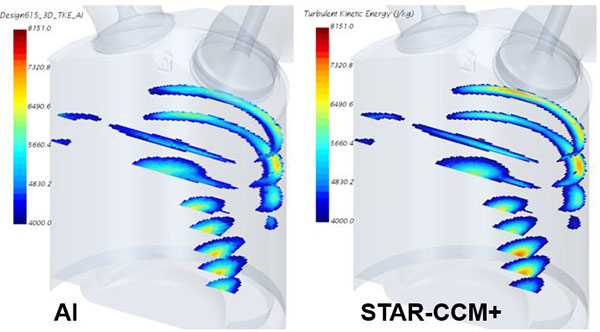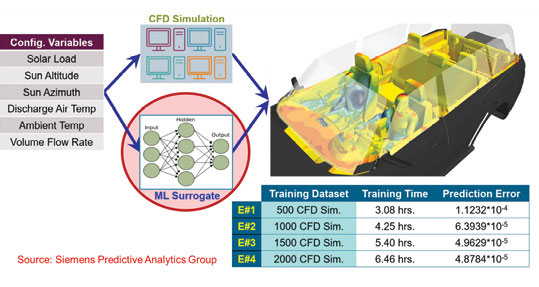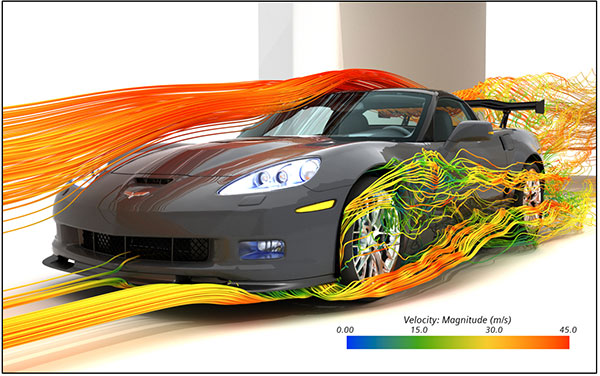How Reduced Order Models are Changing the Design Process
Thanks to advances in artificial intelligence (AI) and machine learning (ML), it is possible to gather and analyze design knowledge.

Fig. 1: AI inferences can be nearly indistinguishable from full simulation results while running in a fraction of the time. Images courtesy of Siemens Digital Industries Software.
Latest News
February 21, 2023
Data is one of the most valuable assets of an engineering or design company; however, effectively capturing and using data can present various challenges.

The knowledge built up within a company over years of design and testing alongside generations of products is not easily captured in a database or binder. It is diffused across hundreds or thousands of designs and the processes used in their creation. With modern product design the demand for better, smarter products delivered on increasingly short development cycles means companies cannot afford to let valuable data escape them nor merely accumulate the data without leveraging it to its full potential.
Now, thanks to advances in artificial intelligence (AI) and machine learning (ML), it is possible to gather and analyze this design knowledge. Major new technologies being enhanced by AI and ML are reduced order models (ROMs), a broad term for a collection of techniques used to rapidly collate and analyze data.
Once trained using simulation and design data, these new models can provide accurate and real-time inferences about how a component or system will behave (Fig. 1). This reduces or potentially eliminates the need to run long and costly simulations for every design change.
By using ROMs, companies can make use of the wealth of available design data they possess through a surrogate of a product’s various systems to help shorten development cycles, while also broadening the design space.
Capturing Knowledge Through AI
As products and processes grow more complex, they also generate more data during their design, testing and usage. This type of big data, while important, is difficult to extract value from using conventional methods. AI, however, is ideally situated to leverage that data to maximum effect by intelligently sampling the available datasets to understand the relationship between inputs and outputs at key points within the domain. This key data then trains a ROM capable of making inferences within that domain. With this approach, a ROM can not only encapsulate the design knowledge inherent within the training data but also offer a new way to use it (Fig. 2).
An example of this would be designing an internal combustion engine (ICE) for a car. This involves a large number of complex and data-rich simulations to be run throughout the design process. By training an AI model using early simulation data, extracting the pattern that exists relating various input variables such as material choice or fuel ratio to outputs such as torque or heat, it can then be used to accurately infer the outcome of a full simulation in real time instead of in hours or days.

AI Advances Design Development
Once a user creates an ML-based ROM, they can use it in various ways to speed the design process and expand the design space. As alluded to earlier, a ROM based on previous detailed simulations can run in real (or close-to-real) time. After enough simulations have been run to train the model, it can replace the need to run a full simulation every time the user wants to inquire about a new design point.
It is important to note that these models go beyond simple interpolation by using the patterns in their training data to infer the answer to similar, but distinct, cases that fall outside the range of the simulations they were trained on. This means that not only is the equivalent of a high-fidelity simulation being achieved in a fraction of the time, but in the case of needing to make a major change in a parameter, the model is still capable of providing guiding inferences without having to completely rerun long simulations, offering the ability to provide basic validation of major changes quickly. In case further simulations are run, the data from them can also be used to refine the model as well in a process called active learning.
The ability of ROMs to quickly help validate whether a concept is worth pursuing is another major advantage. Many modern products, such as a smartphone or a car, are far too complex for a single person or team to quickly say whether a design concept is viable with many factors, such as operating temperatures and pressures, power consumption or physical stresses needing to be accounted for before a design can be considered viable (Fig. 3).
While some variables can be checked easily, some require mock-ups and low-fidelity simulations to validate concepts. Even a low-fidelity simulation requires time to complete compared to doing a few simple calculations or querying an AI model. However, by using a surrogate ROM, it’s possible to receive nearly instant validation.
The use of AI to speed up the slow validation of design concepts in an already tight development cycle time is freed up to explore a wider design space, conduct additional testing on a finished design or bring new designs to market faster.

Fig. 3: Fully simulating a car takes too long to quickly validate a design concept. With ROMs, it’s possible to validate requirements quickly.
Building Trust in an AI Model
Regarding artificial intelligence, trust is crucial. It’s a multifaceted problem but there are a variety of solutions that are widely used and industry agnostic. For example, one potential solution is blind validation exercises where the data is segregated ahead of time, with some data being used for training, some for testing and some being held aside and reviewed for validation.
Whatever method is deployed, it all comes down to data analysis. That requires a solution that can recommend the best way to separate the data and the optimal way to apply a model or even where not to apply it. Today, software suites such as Simcenter can offer this type of functionality, providing insight into the data in a way that end users can understand.
Another important aspect of trust is offering some level of transparency about what models are available, which are selected, and letting the user see that without an opaque wall. Lastly, particularly within the realm of applying AI to engineering, simulation and physics, it is possible to create physics-informed features, datasets and machine learning models.
Using AI and ROMs based on these physics-informed models, it is possible to predict how the AI will react over a certain domain of the physics, replacing the black-box neural networks that are traditionally associated with AI. Instead, it is now a gray box where the results of the model inferences can be easily traced back to the laws of physics.
Promising Future for Design
With an ever-growing need for smarter, more innovative products delivered on increasingly short development cycles, AI represents a powerful tool to not only capture and use the knowledge latent within the design of past generations of products but also to speed up the design process.
Thanks to the power of AI-driven ROMs, less time can also be spent running slow simulations and more time on exploring a broader design space, helping to drive innovative product design by building on the benefits of past design data, now encapsulated within easy-to-use accessible models.
Justin Hodges is an AI/ML technical specialist in product management at Siemens Digital Industries Software. At Siemens, Hodges is striving to augment the capabilities of engineering simulation using machine learning.
Subscribe to our FREE magazine, FREE email newsletters or both!
Latest News






